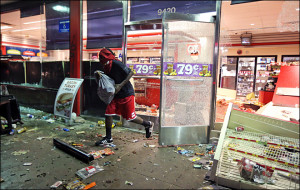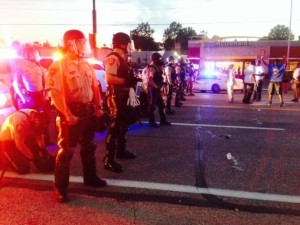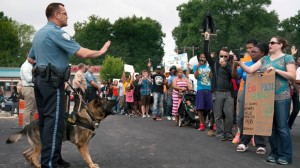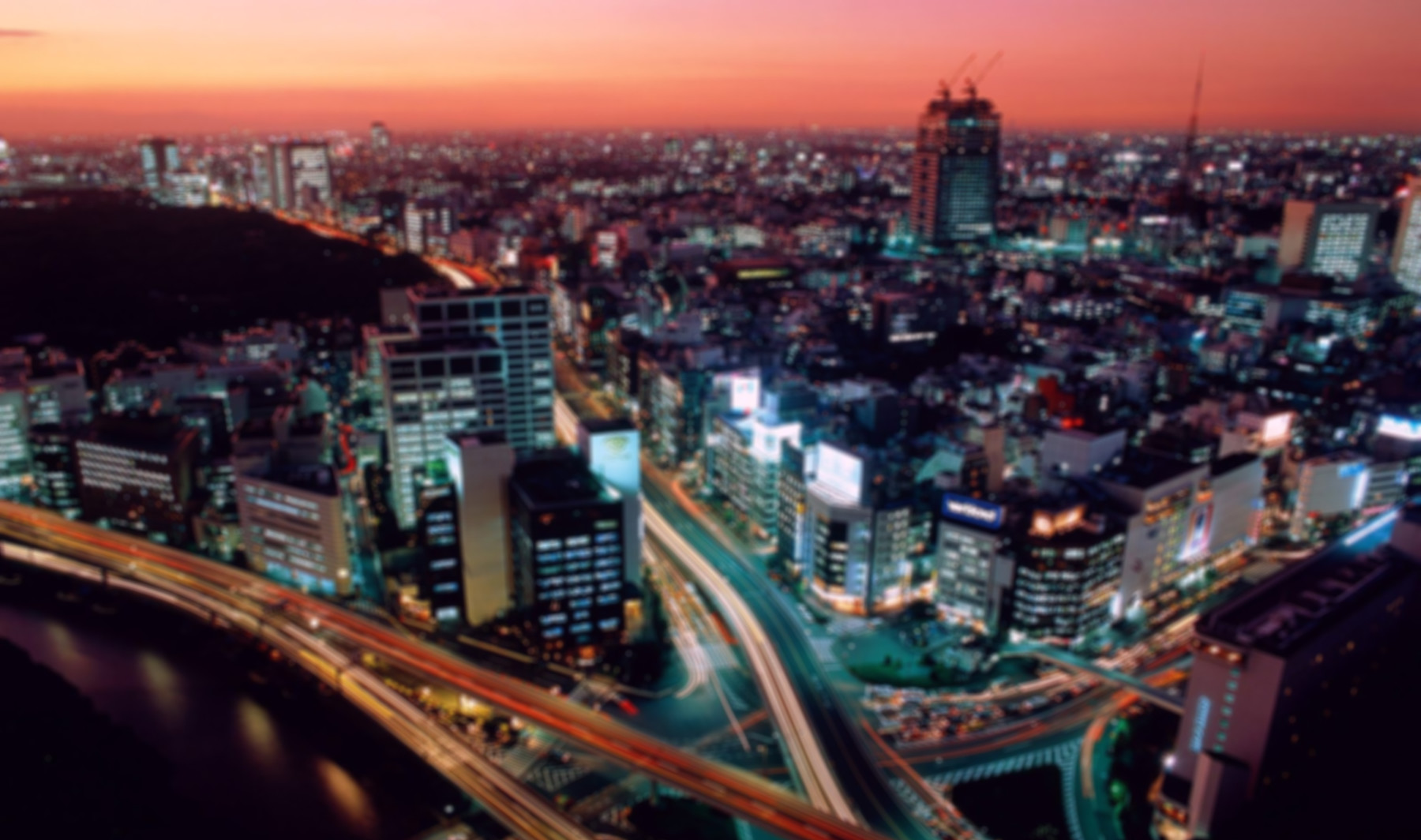
The death of unarmed Michael Brown at the hands of police exploded into a full riot that threatens to destroy a community
by Ed Button
It’s been a long weekend, and it’s shaping up to be a long week.
In case you’ve been living under a rock, 18-year-old Michael Brown was shot and killed by a police officer in the Ferguson area of St. Louis County Saturday afternoon, kindling a fire of national outrage concerning the death of yet another unarmed person at the hands of
police.
The story of what lead to the shooting is, at this time, muddled: the story from the law enforcement side of things is that Brown was shot and killed after the officer in question made contact with Brown and a friend of his outside of an apartment complex. A physical altercation occurred. Brown pushed the six-year law enforcement veteran into his patrol car and attempted to take the officer’s gun. A shot went off inside the vehicle, and, eventually Brown was shot and killed by the officer.
Witnesses say that the officer in question told Brown and his friend to get out of the road, and later grabbed him by the neck. A scuffle ensued and Brown was shot dead. Others say that Brown was running away from the officer when he was first shot, and after getting up off the ground with his hands in the air, was shot two more times before falling for the final time.
The officer involved in the shooting has been put on paid administrative leave during the investigation, a standard procedure after an incident like this.
Now, assuming that the situation proposed above by the police is what happened, and as the investigation into this awful situation continues, questions arise: Why was Brown, who was unarmed at the time of his death and reportedly surrendering, shot and killed as opposed
to chased down and arrested? Why would he assault the officer in the first place? And, if the investigation finds that the officer was justified in his use of force, what will happen then?
 Unfortunately, we got a taste of the answer to that last question Sunday night: after a mostly peaceful demonstration that morning, anarchy reared its ugly head later in the evening, as looting, vandalism and lawlessness gripped Ferguson. At the end, a number of businesses near the scene of the shooting were damaged, a gas station was gutted and destroyed after being set on fire, vehicles had their windows broken, 32 people were arrested, and two police officers suffered minor injuries. SWAT teams were seen throughout the town.
Unfortunately, we got a taste of the answer to that last question Sunday night: after a mostly peaceful demonstration that morning, anarchy reared its ugly head later in the evening, as looting, vandalism and lawlessness gripped Ferguson. At the end, a number of businesses near the scene of the shooting were damaged, a gas station was gutted and destroyed after being set on fire, vehicles had their windows broken, 32 people were arrested, and two police officers suffered minor injuries. SWAT teams were seen throughout the town.
More stand-offs between protesters and law enforcement took place Monday morning, and as I edit this Monday evening, roads are being closed in Ferguson by officers in full riot gear. In a blatant violation of the First Amendment, a reporter from a St. Louis TV station was threatened with tear gas if he didn’t leave his post (behind the police tape, mind you) because an officer told him “they were putting cops’ lives in danger”. One of the malls shut down in the evening after a massive brawl that seemingly isn’t connected to the Ferguson incident. And the fudgy poo icing on this cake of crap? Al Sharpton, who is seen by many as a harbinger of awful race problems to come, is scheduled to visit the city, if he isn’t there already.
 Places I’ve traversed, places I grew up in, look like a war zone. Waking up to those images and videos this morning broke my heart, and my heart is still heavy this evening. My beloved city is seemingly tearing itself apart.
Places I’ve traversed, places I grew up in, look like a war zone. Waking up to those images and videos this morning broke my heart, and my heart is still heavy this evening. My beloved city is seemingly tearing itself apart.
For those of you hoping for a quick, clear-cut end to this madness, don’t hold your breath: Ferguson Police Chief Tom Jackson told local TV station KSDK Sunday that they do not believe there is civilian video footage of the shooting. The department doesn’t have police
dashboard cameras, and recently purchased body cameras for officers, but they haven’t been put into service yet. The case has been turned over to the St. Louis County Police Department, and now the FBI and Justice Department is running a parallel investigation into the incident.
Back to the riots for a second: what would lead people to riot and destroy their own neighborhoods? For some, I’m sure it’s an excuse to get free stuff, as was the case with some during the looting of a gas station on Sunday.
For some, I’m sure it’s a distrust of police, warranted or unwarranted – the Missouri Attorney General’s office reports African-Americans make up 65 percent of Ferguson’s population, yet they accounted for 93 percent of arrests, 92 percent of searches and 80 percent of traffic stops in the city last year. The same report states that black people in Ferguson are twice as likely to be stopped by police as whites, even though police find contraband more often when searching white people, 34 percent versus 22 percent. The distrust also probably stems from the Ferguson Police Department’s make-up: out of 53 total commissioned officers, three are black and two are other minorities. For others though, it may be attributed to a sense of hopelessness. A sense of getting back at the society that harmed them, or wronged them, or left them behind, neighborhoods be damned.
To me, there’s something wrong with an unarmed man being, from what we understand, shot in the back by law enforcement. However, looting and destroying your community is not the answer and should never be considered under any circumstance. You’re not helping the cause any, you’re not honoring the dead, and in fact, others could be put in
harm’s way.
Despite all of the facts not being completely known in the case, the constant peanut gallery that is the Internet seems to have no problem jumping to their own conclusions: Brown was, by most accounts of people that knew him, a decent kid who, despite some run-ins with the law a few years ago, was excited to start college this week. Now this young man is being called a “thug”, a “gangster”, and worse from people I know. And worse, people that I know that didn’t know him and weren’t there.
Was he an angel? Probably not. What teenager is? Does his past justify him being shot and killed in the present? Hardly.
 After what has happened and continues to happen in Ferguson, there are serious questions we need to ask ourselves: Why are police seen as a negative force in poorer communities? Why are police using deadly force at a seemingly larger rate? How can we all work together to help those in poorer areas turn around? How do we in the media help or harm in these situations? If I was the law enforcement officer and Brown was attempting to take my gun, would I have acted differently, in the heat of the moment? Would any of us? And why do some of us blame the victim in some instances, and not in others?
After what has happened and continues to happen in Ferguson, there are serious questions we need to ask ourselves: Why are police seen as a negative force in poorer communities? Why are police using deadly force at a seemingly larger rate? How can we all work together to help those in poorer areas turn around? How do we in the media help or harm in these situations? If I was the law enforcement officer and Brown was attempting to take my gun, would I have acted differently, in the heat of the moment? Would any of us? And why do some of us blame the victim in some instances, and not in others?
So many questions. So many problems in both the society-at-large and with some facets of law enforcement. What are the answers? Honestly, I don’t know. Unfortunately, this story doesn’t seem to have any easy answers. I just hope that at the end of the day, justice will prevail, Ferguson can heal, and something good can come out of this awful situation.
And, no matter what the case, I hope that all of us can do the humane thing in instances like this, and keep our damn mouths shut, and wait until the facts are out before we jump to any conclusions.
Ed Button is an award-winning broadcaster based out of West Plains, MO. You can find him on Twitter @edb87.

One Reply to “The Fire This Time: Ed Button Tries To Make Sense Out Of Ferguson”